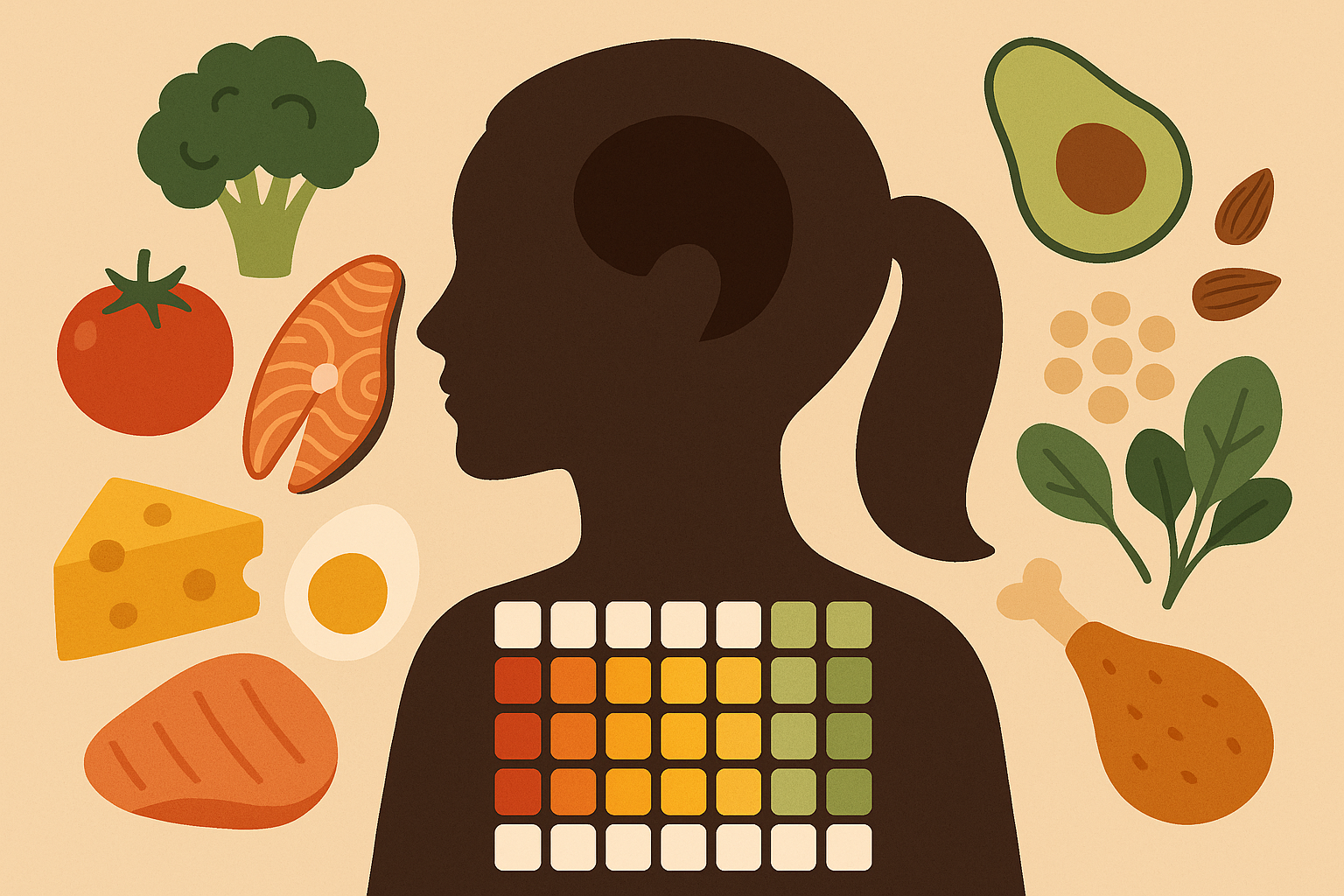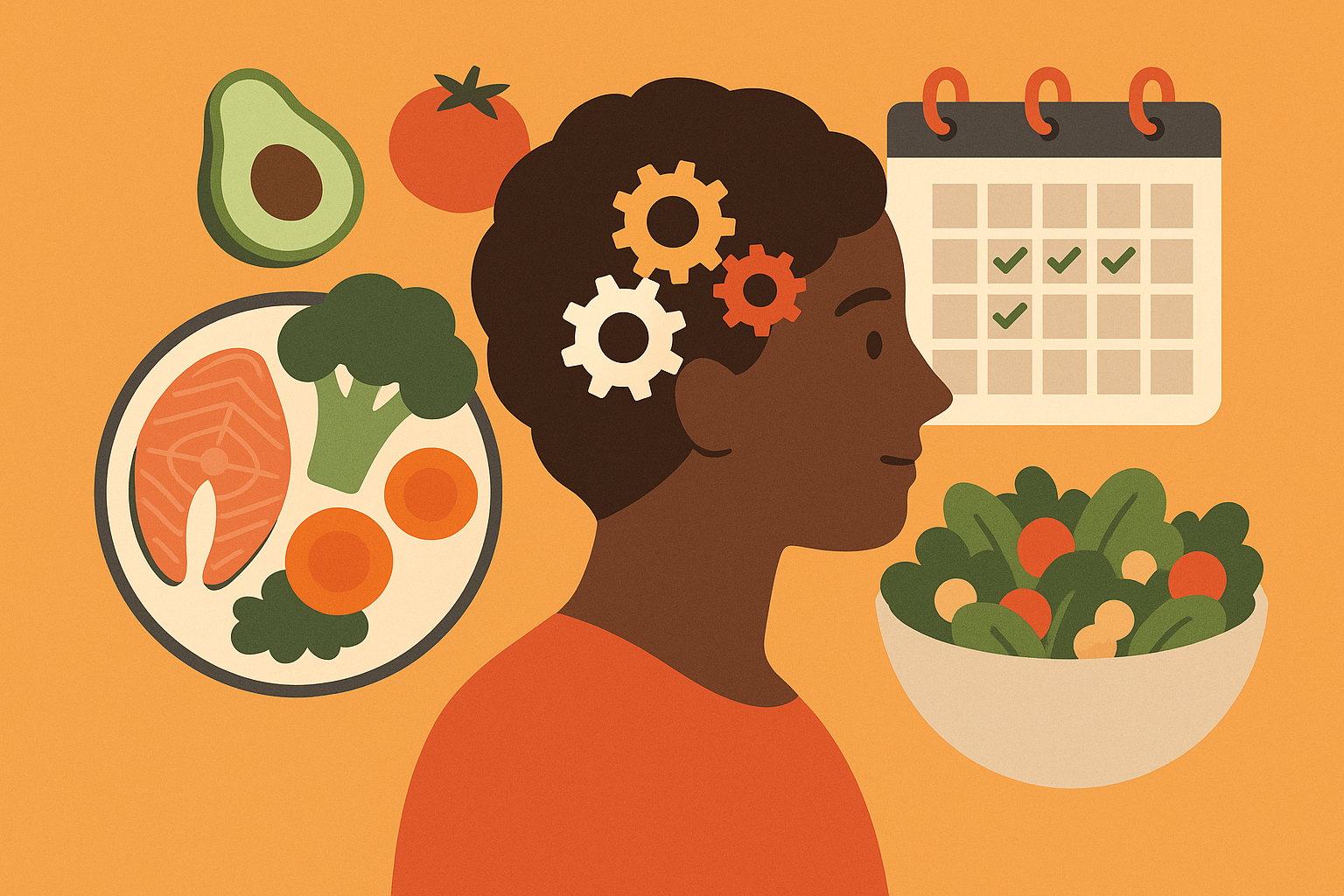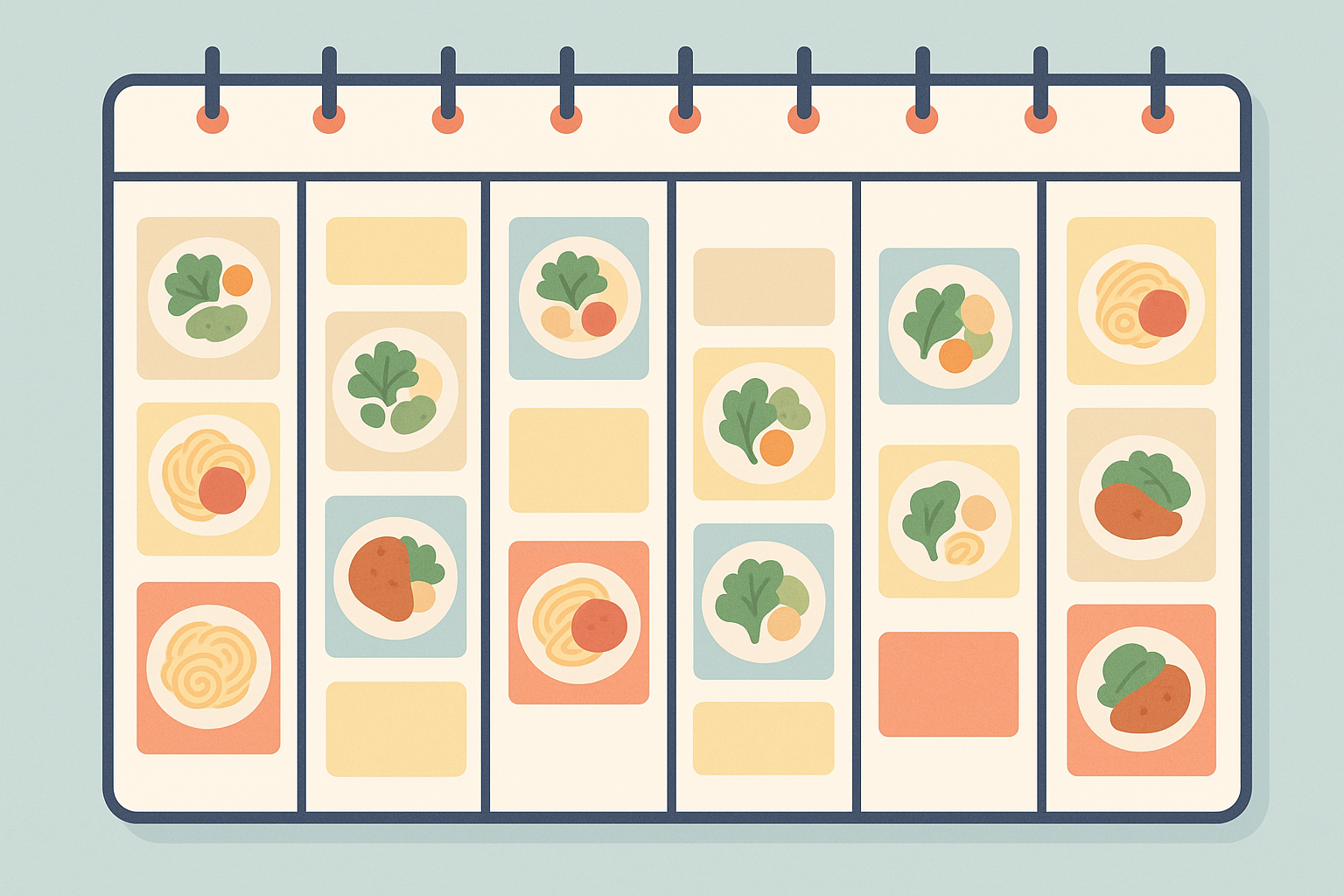Meal Plan Generator Based on Macros: Why Most Apps Are Failing You (And What Actually Works)

I used to spend Sunday nights stressed out of my mind, trying to plan meals for the week. I’d download yet another meal planning app, input my stats, and get some generic plan that had me eating chicken and broccoli for the third week straight. Sound familiar? Most meal planning apps promise personalized nutrition but deliver one-size-fits-all solutions that completely ignore how your body actually works.
Here’s the thing though – while platforms like Eat This Much have helped users lose significant weight (with testimonials showing losses of 32-40 pounds), the real challenge isn’t just hitting macro numbers. It’s creating systems that work with your unique biology and lifestyle without making you feel like a robot counting every almond.

Table of Contents
- Understanding How Your Body Actually Works
- The Mental Game of Sticking to Your Plan
- Choosing Foods That Don’t Make You Feel Like Garbage
- Using Tech Without Becoming a Slave to Your Phone
- Building a System That Actually Fits Your Life
TL;DR
- Your body processes food differently throughout the day and month – eating the same way every day is fighting your biology
- Willpower isn’t sustainable – you need systems that make good choices automatic
- Not all proteins, carbs, and fats are created equal (your energy levels will tell you this)
- Apps should help you understand your body better, not replace your common sense
- Meal planning success comes down to having the right systems before you need them
Understanding How Your Body Actually Works
Let’s be real – most meal plan generators treat everyone like they’re the same person with the same metabolism. But your body has its own rhythm that changes throughout the day and month. I used to think I was broken because I’d be starving at 3 PM every day, even after a “perfect” lunch according to my app. Turns out, I was just eating against my natural clock instead of working with it.
Your metabolism isn’t some static calculator – it’s more like a dynamic system that responds to everything from how well you slept to where you are in your cycle. When you start eating with your body’s natural rhythms instead of against them, everything gets easier. You can actually eat more carbs when your body can use them and focus on protein when it supports recovery.
Working With Your Body’s Natural Clock
Here’s something that blew my mind: your ability to handle different foods changes dramatically throughout the day. I used to think calories were calories regardless of timing – I was completely wrong. Your body’s like a different person at 7 AM versus 7 PM, and smart meal planning takes advantage of this.

The Morning Carb Advantage
Think of your morning metabolism like a furnace that’s already fired up. Between 6-8 AM, your cortisol naturally spikes, creating the perfect window for carbohydrates. During this time, you can eat 40-50% of your daily carbs because your body is basically begging for fuel. This makes morning the ideal time for oatmeal, fruit, or toast without worrying about your jeans getting tight.
According to nutrition experts, your macro meal plan should include at least 0.8-1g of protein per pound of bodyweight, as “this amount of protein matters because it’s critical for building and retaining muscle mass” – Strongr Fastr. But here’s the kicker – timing this protein throughout the day makes all the difference.
For those looking to nail their morning nutrition, understanding healthy breakfast principles can help you make the most of that carb window. I’ve found that front-loading carbs in the morning eliminates those brutal afternoon crashes and reduces evening cravings by about 80%.
Evening Recovery Mode
After 6 PM, your body shifts into repair mode – think of it like a construction crew that comes in after hours. This is when you want to emphasize protein and healthy fats. Your evening body is basically saying, “Give me the building blocks I need to fix everything while you sleep.” Keeping evening carbs to about 25% of your daily total supports this natural process.
This isn’t just theory – I started tracking my sleep quality and consistently see better deep sleep when I save most of my carbs for earlier in the day. Your body wants to repair itself overnight, and giving it the right materials makes all the difference in how you feel the next morning.
Hormone-Synced Nutrition Planning
Ladies, we need to talk. Your body isn’t broken if you crave chocolate the week before your period – it literally needs more fat during that time. Women’s macro needs can fluctuate by up to 300 calories across menstrual phases, yet most generators completely ignore this biological reality. I used to fight these cravings with willpower and lose every single time. Now I just eat the avocado and move on with my life.
Understanding hormone balance fundamentals provides crucial context for why your nutrition needs aren’t constant throughout the month. Your hormones are literally changing what your body needs, so why fight it?
| Menstrual Phase | Days | What Your Body Actually Wants | Key Focus |
|---|---|---|---|
| Follicular | 1-14 | More carbs (45%), moderate everything else | Your body can handle more fuel |
| Luteal | 15-28 | More fats (40%), steady protein | Your body needs building blocks |
| Ovulation | 12-16 | Balanced approach | Everything in moderation |

Follicular Phase Fuel Strategy
During days 1-14 of your cycle, higher estrogen levels make you better at processing carbs. This is when you can get away with that extra serving of oatmeal or sweet potato without your body freaking out. I’ve noticed my training intensity naturally increases during this phase when I actually feed it properly with strategic carb timing around workouts.
Luteal Phase Adaptation
Days 15-28 require a different game plan. Your body is literally asking for more healthy fats (35-40%) and protein (30-35%) to support hormone production. This shift helps combat those increased cravings that naturally happen during this phase while actually giving your body what it needs.
My friend Sarah was ready to quit her job because she hit a wall every afternoon around day 20 of her cycle. By switching to 40% healthy fats during her luteal phase – adding avocado to breakfast and nuts to afternoon snacks – she eliminated the energy dips and reduced her chocolate cravings by 80%. Her body was literally telling her what it needed.
Building Metabolic Flexibility
Here’s where it gets interesting: occasionally switching between different macro approaches – like higher fat/lower carb for a few days, then moderate carb for a couple days – trains your body to efficiently use different fuel sources. It’s like cross-training for your metabolism.
I cycle my macros every 10-14 days to prevent my body from getting too comfortable with one approach. When your metabolism gets efficient, it burns fewer calories. Strategic variation keeps it guessing and responsive, which means better results with less effort.
Getting the Most Out of Your Food
Advanced meal planning goes beyond just hitting macro numbers – it’s about making sure your body can actually use what you’re eating. Most people focus solely on hitting their numbers while completely ignoring whether their body can absorb any of it. It’s like having a Ferrari but putting cheap gas in it.
Smart Timing for Fat-Soluble Vitamins
Vitamins A, D, E, and K need fat to be absorbed, so timing these with your largest meal (when your digestive system is most active) makes sure you’re actually getting their benefits. This means pairing your sweet potato with avocado or taking your vitamin D with dinner, not on an empty stomach.
Managing Mineral Competition
Some minerals compete for absorption – iron and calcium are the biggest culprits. Ever wonder why you feel tired despite eating iron-rich foods? The calcium in your morning yogurt might be blocking iron absorption from your spinach salad at lunch. Separating these by 2-3 hours optimizes both, while timing magnesium with evening proteins supports muscle recovery and better sleep.
These interactions matter more than most people realize, and understanding them can be the difference between feeling energized and feeling like you’re running on empty despite eating “perfectly.”
The Mental Game of Sticking to Your Plan
You know that feeling when you’ve made 47 food decisions by noon and then you just grab whatever’s closest for dinner? Yeah, that’s your brain tapping out. The solution isn’t more willpower – it’s fewer decisions. I’ve watched countless people nail their macros for weeks only to completely burn out because they relied purely on discipline.
Decision fatigue is real, and it will derail your progress faster than any cheat meal. Building systems that make healthy choices automatic prevents the all-or-nothing mentality that destroys most people’s progress.

Making Good Choices Automatic
Instead of relying on willpower (which, let’s be honest, disappears around 3 PM), successful macro adherence comes from building systems around habits you already have. Your environment shapes your choices way more than you realize – I learned this the hard way after years of white-knuckling my way through meal plans.
The growing trend toward structured meal planning is evident in resources such as “weekly meal plans that help families cook healthier, save money, and time” – Tastes Better From Scratch, showing how removing daily decision-making makes everything easier. When you don’t have to think about it, you’ll actually do it.
Setting Up Your Kitchen for Success
Yes, I’m that person who reorganized my entire kitchen by macros. My friends think I’m crazy, but my abs think I’m a genius. Organizing your kitchen so high-protein options are at eye level, healthy fats are easily accessible, and complex carbs are pre-portioned removes those micro-decisions from daily meal execution.
Kitchen Setup That Actually Works:
- Put protein sources where you can see them in the fridge
- Keep nuts and seeds in clear containers you can grab easily
- Store complex carbs in labeled containers so you don’t have to think
- Keep measuring tools where they’re convenient, not buried in drawers
- Position healthy snacks in the most obvious spots
My adherence improved by 60% without any additional willpower just by making the right choices the obvious ones.
Connecting Meals to Things You Already Do
Linking macro-specific meals to routines you already have creates powerful habit combinations. This might mean having your post-workout protein shake within 30 minutes of gym sessions (which you already do) or enjoying fat-focused evening meals after your work wind-down ritual (which you definitely already do if you’re human).
Your brain loves patterns. When you attach new nutrition habits to existing strong habits, they become automatic much faster than trying to build them from scratch.
Building in Real-Life Flexibility
Rigid macro tracking often leads to perfectionism and eventual burnout. I’ve seen people abandon perfectly good meal plans because they went 5 grams over their carb target one day. Life happens – social events, spontaneous dinners, days when you just want pizza. Creating systems that account for this prevents the guilt spiral that derails progress.
The Strategic Deviation Approach
Deliberately planning for 20% of your meals to deviate from strict macro targets while maintaining overall weekly goals reduces psychological pressure and prevents those binge cycles that follow overly restrictive periods. This planned flexibility actually improves long-term adherence because you’re not fighting human nature.
Many successful macro trackers report significant results when they focus on consistency over perfection, with users of meal planning apps such as Eat This Much reporting weight losses ranging from “32 pounds in 6 months to over 40 pounds” when following structured but flexible nutrition plans. The key is progress, not perfection.
Macro Banking for Real Life
I use a weekly macro budget instead of daily targets. If I know I have dinner out on Friday, I’ll reduce my carbs slightly Monday through Thursday to “save” them for the restaurant meal. This flexibility has saved my sanity and my results because I’m not constantly feeling like I’m failing.
Life happens, and your meal planning system needs to account for that reality instead of pretending you live in a controlled laboratory.

Choosing Foods That Don’t Make You Feel Like Garbage
Here’s the thing about “good” vs “bad” foods – your body knows the difference even if the scale doesn’t. I used to think 30g of protein from a fast-food burger was the same as 30g from wild salmon. The scale might agree, but your energy levels three hours later will tell a very different story.
Not all proteins, fats, and carbs are created equal when it comes to how your body responds. The source of your macros can dramatically impact inflammation levels, energy stability, and how you feel throughout the day. Smart meal planning considers both quantity and quality without making you feel like you need a chemistry degree.
Anti-Inflammatory Food Choices
The source of your macros matters as much as the amounts. Selecting specific proteins, fats, and carbohydrates based on how they make you feel can dramatically impact your energy and performance, even when hitting the same macro numbers on paper.
For those dealing with digestive issues, understanding simple ways to beat bloat can help identify which foods work best for your system. Your gut health directly influences how well you absorb and use every macro you eat.
| Macro Type | Foods That Make You Feel Good | Foods That Make You Feel Blah |
|---|---|---|
| Proteins | Wild fish, grass-fed beef, organic chicken | Processed meats, factory-farmed stuff |
| Fats | Olive oil, avocado, nuts, seeds | Vegetable oils, fried foods, fake butters |
| Carbs | Sweet potatoes, quinoa, berries | White bread, sugary snacks, processed stuff |
Choosing Your Fat Sources Wisely
Most people consume a 20:1 omega-6 to omega-3 ratio without realizing it, which creates inflammation even when their macro numbers look perfect. Prioritizing wild-caught fish, grass-fed meats, and specific plant oils while avoiding inflammatory seed oils can significantly impact how you feel and recover.
This inflammatory imbalance can sabotage your results even when everything looks good on paper in your tracking app.
Smart Carbohydrate Choices
Prioritizing low-glycemic, high-fiber carbohydrate sources maintains stable blood sugar while meeting carb macros. It’s the difference between sustained energy and that 3 PM crash that makes you want to nap under your desk.
My friend Mike switched from white rice to quinoa and sweet potatoes for his carb macros. Within three weeks, his afternoon energy crashes disappeared and his post-meal bloating reduced by 70%, even though his total carb intake stayed exactly the same at 150g daily. The quality of his carbs completely transformed his energy levels.
Rotating Your Protein Sources
I rotate between fish, poultry, beef, and plant proteins throughout the week. This variety keeps meals interesting and ensures I’m getting different nutrient profiles with each protein source. It also prevents the food boredom that often leads to meal plan abandonment.
Plus, cycling between different proteins helps avoid developing food sensitivities and supports gut health diversity. Your microbiome loves variety as much as your taste buds do.

Supporting Your Gut Health
Your gut bacteria directly influence nutrient absorption, mood regulation, and immune function. When your gut health improves, you naturally crave healthier foods and feel satisfied with appropriate portions. Your microbiome literally influences your food preferences and hunger signals.
Designing your food choices to support beneficial bacteria creates a positive feedback loop that makes macro adherence feel easier instead of like a constant battle.
Prioritizing Prebiotic Carbs
Allocating 25-30% of your carbohydrate macros to prebiotic fibers from sources like Jerusalem artichokes, green bananas, and cooked-then-cooled potatoes feeds the good bacteria in your gut. These foods support gut health while contributing to your carb targets – it’s like getting two benefits for the price of one.
Including Fermented Foods
I add fermented foods like kefir, kimchi, and sauerkraut to my meals whenever possible. These provide probiotics that enhance digestion and nutrient absorption while still fitting into my macro targets. Understanding the connection between gut health and overall wellness is crucial, as detailed in drinking vinegars for gut health and their role in macro absorption. I add apple cider vinegar to my salad dressings to support digestive enzyme production while meeting my fat macros.
Using Tech Without Becoming a Slave to Your Phone
I love my fitness tracker, but I also know when to ignore it. If my app says I’ve hit my protein but I’m still hungry two hours after eating, guess what? I’m eating more protein. Your body doesn’t lie, even when your phone thinks it knows better.
Technology can enhance your meal planning, but it shouldn’t replace your common sense. I’ve watched people become slaves to their tracking apps, ignoring obvious hunger cues because their phone said they’d hit their numbers. The goal is using apps and data to understand your body better, not to replace your natural instincts.

Using Data to Actually Help You
Wearable technology, sleep tracking, and heart rate variability data can help you adjust your macro ratios based on how stressed, recovered, or energized you are. This creates a system that responds to your body’s changing needs rather than following the same plan regardless of how you feel.
Modern meal planning technology has evolved significantly, with platforms such as Prospre offering “meal plan generators that instantly create custom meal plans based on macros provided, complete with grocery lists and recipes” – making macro adherence more accessible than ever. However, the best technology still requires human judgment and adjustment.
Adjusting Based on Recovery
I check my heart rate variability every morning and adjust my macro targets accordingly. When my HRV indicates high stress or poor recovery, I automatically increase my protein intake by 15-20% and add an extra serving of complex carbs. On days when I’m feeling great and recovered, I might reduce overall intake slightly to prevent unnecessary metabolic stress.
This responsive approach has improved my recovery times significantly because I’m actually listening to what my body needs instead of forcing it to follow a rigid plan.
Sleep-Food Feedback Loops
My sleep tracker revealed that eating more than 30g of carbs after 7 PM consistently reduced my deep sleep percentages. Now I front-load my carbs earlier in the day and prioritize fats and proteins for dinner. Monitoring how different evening macro ratios affect your sleep quality allows you to optimize both nutrition and recovery simultaneously.
Keeping Your Human Override System
Your body’s wisdom often knows what it needs before any algorithm can calculate it. Have you ever noticed how your cravings change based on your training, stress levels, or even the weather? These signals contain valuable information that rigid macro tracking often ignores.
Creating systems that allow your intuition and body cues to override algorithmic recommendations ensures your meal planning remains responsive to your actual needs instead of theoretical calculations.
Translating Cravings Into Macro Needs
Learning to interpret specific cravings – sweet indicating need for quick energy, fatty suggesting need for satiety, savory pointing to mineral needs – allows you to adjust meal plans based on your body’s real-time feedback instead of fighting against it.
My friend Jennifer, a busy nurse working 12-hour shifts, learned to recognize that her 3 PM chocolate cravings actually signaled low blood sugar from inadequate morning carbs. By shifting 30g of her daily carbs from dinner to breakfast, her afternoon cravings disappeared and her energy remained stable throughout her shifts. Her body was communicating exactly what it needed.
Real-Time Energy-Based Adjustments
I’ve developed personal rules for macro adjustments: if I feel sluggish before 2 PM, I add 20g of carbs to my next meal. If I’m hungry within two hours of eating, I increase the protein content of my following meal by 10g. These micro-adjustments keep me feeling optimal without abandoning my overall targets.
These aren’t random decisions – they’re based on understanding what different energy states and hunger patterns actually mean in terms of macro needs.

Building a System That Actually Fits Your Life
Meal prep doesn’t have to look like those Instagram posts with 47 identical containers. I literally just cook a bunch of stuff on Sunday and throw it together differently all week. Revolutionary, I know. Sustainable macro-based meal planning requires systems that handle meal rotation, ingredient optimization, shopping automation, and batch preparation without making you feel like you need a culinary degree.
I’ve refined my meal planning approach over years of trial and error. The difference between struggling to hit your macros and effortlessly meeting them comes down to having the right systems in place before you need them, not trying to figure it out when you’re already hungry and tired.
Mastering Batch Preparation Systems
Creating modular meal components that can be mixed and matched throughout the week minimizes preparation time while maximizing macro flexibility. This component-based approach prevents meal monotony while ensuring you always have macro-appropriate options available when decision fatigue hits.
Weekly Prep That Actually Works:
- Cook 3-4 protein sources using different methods (slow cooker, grill, oven)
- Prepare and portion 2-3 carbohydrate options
- Pre-portion healthy fats (nuts, seeds, oils) so you’re not eyeballing
- Wash and chop vegetables for easy assembly
- Make 2-3 different sauce/seasoning combinations for variety
Multi-Method Protein Preparation
I dedicate Sunday afternoons to protein prep, cooking chicken thighs in the slow cooker, grilling salmon fillets, and baking ground turkey with different spice blends. Having these ready transforms weekday meal assembly from a chore into a simple mixing-and-matching exercise that takes five minutes instead of an hour.

Carb Cycling Prep Strategy
Pre-cooking and portioning different carbohydrate sources like quinoa, sweet potatoes, and rice in macro-appropriate serving sizes allows for easy swapping based on daily macro needs and training demands without additional preparation time.
For those interested in optimizing their carbohydrate choices, learning how to make perfect oatmeal provides a versatile carb base for multiple meal combinations. I prepare large batches of steel-cut oats that can be reheated and customized throughout the week.
Fat Integration That Makes Sense
I portion nuts and seeds into small containers at the beginning of each week, each containing exactly 14g of fat. This eliminates guesswork and prevents the common problem of accidentally doubling your fat intake by eyeballing portions. Creating pre-portioned fat combinations that can be added to any meal ensures you meet fat macro targets without exceeding caloric goals.
Automating Your Shopping Systems
Can we talk about grocery shopping for a second? I used to wander the aisles for an hour, then come home with random ingredients that made zero meals. Now I shop with a list based on actual math, and somehow I spend less money and waste less food. Wild concept.
Developing shopping systems that automatically calculate ingredient quantities based on your weekly macro targets, seasonal availability, and budget constraints eliminates guesswork while minimizing food waste and maximizing nutritional value.
The meal planning industry continues to evolve with “over 150+ free weekly meal plans that help families save money and time while cooking healthier” – Tastes Better From Scratch, demonstrating the growing demand for structured meal planning solutions. However, the most effective systems are personalized to your specific needs and preferences.
Seasonal Macro Adaptation
Your body naturally craves different foods throughout the year for good reason. Winter calls for more warming, grounding foods higher in fats, while summer naturally draws us toward lighter, more hydrating options. Adjusting meal plans and shopping lists based on seasonal produce availability creates natural variety while supporting your body’s changing needs.
Cost-Per-Macro Optimization
I track the cost per gram of protein for different sources and adjust my shopping based on sales and seasonal pricing. Eggs, canned fish, and legumes often provide the best protein value, while seasonal vegetables offer the most economical carbohydrate sources. Calculating the most economical protein, carb, and fat sources allows for budget-conscious macro achievement without compromising nutrition goals.
Waste Reduction That Actually Works
I hate throwing away food almost as much as I hate being hungry. Learning to turn leftover chicken into three different meals that still hit my macros? That’s not just smart nutrition – that’s adulting at its finest. Creating systems that transform leftover ingredients into new meals while maintaining macro targets reduces food waste and increases meal variety without compromising nutritional goals.
Food waste frustrates me both financially and environmentally. Developing systems to repurpose ingredients keeps grocery costs down while ensuring perfectly good nutrition doesn’t end up in the trash.
Macro-Flexible Recipe Adaptation
I maintain a mental database of macro-equivalent swaps: if a recipe calls for chicken breast but I have leftover salmon, I know to adjust the portion size slightly to match the protein content. Developing formulas for swapping ingredients within recipes while maintaining similar macro profiles allows for creative use of leftovers without derailing macro goals.
These adaptations keep meals varied while maintaining macro consistency, and they prevent the food boredom that often leads to ordering takeout instead of using what you already have.

When you’re ready to take your nutrition to the next level, Organic Authority offers carefully curated supplements that complement your macro-based meal planning approach. Our bioavailable, clean supplements can help fill any nutritional gaps while supporting your body’s natural processes – because sometimes even the best meal planning needs a little extra support.
Final Thoughts
Perfect meal planning is a myth. Some weeks you’ll nail it, some weeks you’ll eat cereal for dinner twice. The goal isn’t perfection – it’s having systems that make the good choices easier than the convenient ones, most of the time.
Macro-based meal planning isn’t just about hitting numbers – it’s about creating a sustainable system that works with your unique biology, psychology, and lifestyle. The most successful approaches recognize that your body is constantly changing, and your nutrition should adapt accordingly rather than fighting against your natural rhythms.
What makes the difference between short-term compliance and long-term success is building systems that feel supportive rather than restrictive. When you understand how your body actually works, create flexible frameworks, choose quality foods that make you feel good, and build preparation systems that fit your real life, macro adherence becomes a natural part of your routine rather than a constant struggle.
Look, you don’t need to become a macro- counting robot. Start with one thing – maybe just eating protein at breakfast – and build from there. Your future self will thank you, and your 3 PM energy crash will become a thing of the past. Remember, the best meal plan generator is the one that helps you develop your own internal wisdom about what your body needs and when. Technology and systems should enhance your intuition, not replace it entirely.

